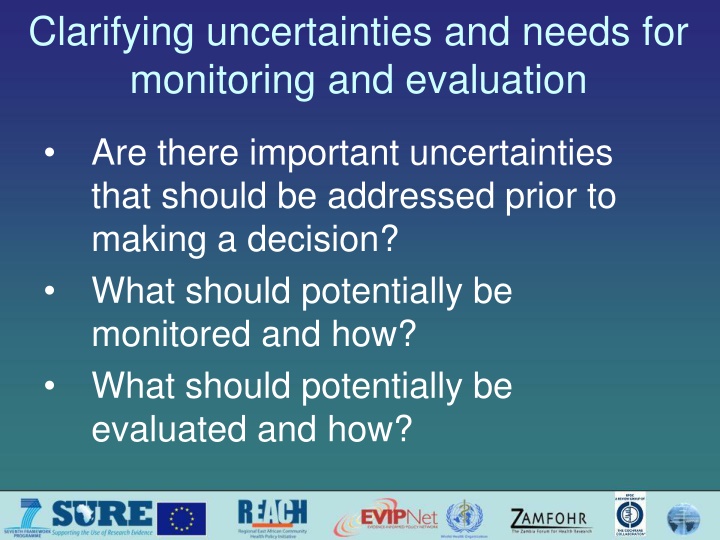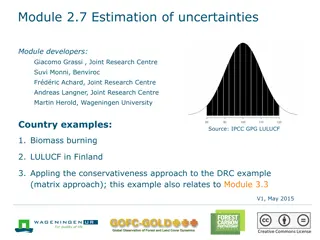Importance of Clarifying Uncertainties and Needs for Monitoring and Evaluation
Uncertainties in decision-making require monitoring and evaluation to reduce risks, identify corrective actions, and ensure desired impacts. Rigorous evaluation is crucial for accountability and resource optimization, as emphasized by leaders like Julio Frenk. Caution is advised when relying on incomplete data, emphasizing the need for thorough evaluation before full implementation to prevent resource wastage and unintended consequences.
Download Presentation

Please find below an Image/Link to download the presentation.
The content on the website is provided AS IS for your information and personal use only. It may not be sold, licensed, or shared on other websites without obtaining consent from the author.If you encounter any issues during the download, it is possible that the publisher has removed the file from their server.
You are allowed to download the files provided on this website for personal or commercial use, subject to the condition that they are used lawfully. All files are the property of their respective owners.
The content on the website is provided AS IS for your information and personal use only. It may not be sold, licensed, or shared on other websites without obtaining consent from the author.
E N D
Presentation Transcript
Clarifying uncertainties and needs for monitoring and evaluation Are there important uncertainties that should be addressed prior to making a decision? What should potentially be monitored and how? What should potentially be evaluated and how?
It is unrealistic to assume that we can predict the impacts of a health policy with certainty Rigorous evaluation is often lacking Policymakers must still make decisions Consequently, some degree of monitoring and evaluation is almost always warranted Providing data will be used to Reduce important uncertainties about implementing an option Identify the need for corrective actions, if things are not going as planned Support continuation of the option, if things are going as planned
Both politically, in terms of being accountable to those who fund the system, and also ethically, in terms of making sure that you make the best use possible of available resources, evaluation is absolutely critical. Julio Frenk (former Minister of Health of Mexico ) Dr Julio Frenk, Minister of Health, Mexico
Are there uncertainties that should be addressed prior to making a decision? It may be prudent to undertake an evaluation before full implementation for options that are promising, but Entail large investments or Important risks of adverse effects Undertaking a rigorous evaluation, for example as a pilot study, can potentially Prevent wasting resources Reduce the risk of unintended impacts Ensure that desired impacts will be achieved
Caution is warranted Whenever judgments about the impacts of an option are based on Theories Surrogate outcomes Limited observational studies or Inadequate randomized impact evaluations The advantages of undertaking an evaluation prior to fully implementing an option are likely to outweigh the disadvantages when there is a substantial risk of The benefits not outweighing the harms and costs or A potential need to make important modifications However, this depends on an evaluation being Possible to complete within an acceptable timeframe Feasible Affordable
Advantages and disadvantages of undertaking an evaluation prior to fully implementing an option Findings of the evaluation The balance between the benefits, harms and costs Favour the policy Do not favour the policy Advantages Potential for improvements prior to implementation Possible to stop implementation and to reconsider options Disadvantages Delay in implementation
Describing uncertainties that potentially should be addressed prior to full implementation in a policy brief Depending on how compelling the arguments are for undertaking an evaluation, such options can be described by Flagging the uncertainties and ensuring that consideration is given to undertaking a prior evaluation Describing full implementation and undertaking a prior evaluation as two different options Describing the option as undertaking an evaluation Indicating that it should not be fully implemented without first undertaking an evaluation
Questions or comments about addressing uncertainties before making a decision?
What should potentially be monitored and how? In describing options in a policy brief, consideration should be given to the need for monitoring The extent to which monitoring is necessary and what should be monitored depends on how much uncertainty there is regarding the inputs, activities, outputs and impacts for an option The extent to which specific types of uncertainty should be described in a policy brief depends on the Degree of uncertainty Potential for monitoring to reduce important uncertainties Feasibility of monitoring Ability and preparedness to act on the results of monitoring
Types of indicators, reasons for monitoring them, and potential actions Indicators Definitions Reasons for monitoring Potential actions Inputs Financial, human and material resources Uncertainty about the magnitude of the resources that are required Adjustments to the budget Activities Ways in which inputs are used Uncertainty about how resources will be used or to ensure that they are used as intended Changes in how resources are allocated or used Outputs Services provided, changes or short-term effects of activities Uncertainty about the immediate effects of activities Changes in the budget, how resources are used, the activities that are undertaken, or a decision to continue or discontinue implementing the option Impacts Desirable and undesirable effects that are important to those affected Uncertainty about the extent to which outputs accurately and completely reflect the likely impacts of the option Changes in the services that are provided or how they are provided, or a decision to continue or discontinue implementing the option or to undertake an impact evaluation
For uncertainties for which there are compelling reasons for monitoring Consideration should be given to which specific indicators to use I.e. specific types of data that could potentially be collected to provide a reliable means to measure inputs, activities, outputs or impacts This may be Simple counts of events E.g. the number of vaccinations conducted within a set period of time Constructs based on various data sources E.g. the proportion of all children being fully immunised before their first birthday The choice of indicators for monitoring should be based on their characteristics, including the extent to which They are acceptable Valid, reliable and consistent data are available They are affordable
Why consider the choice of indicators in a policy brief? To ensure that due consideration is given to important uncertainties and how to address these To inform discussions about the need for monitoring an option during the policy development process The amount of detail that can be included in a policy brief regarding monitoring is limited It may be desirable to include key considerations in the text and more detailed considerations, when relevant, as an appendix The risk of not incorporating these considerations is that monitoring will be considered as an afterthought, rather than as an integral component of the option
Worksheet for considering needs and alternatives for monitoring implementation of an option
Questions or comments about monitoring?
What should potentially be evaluated and how? Although monitoring can sometimes be used to reduce uncertainties about the impacts of an option, often this will not be adequate Evaluation is sometimes used interchangeably with monitoring But evaluation, or more specifically impact evaluation , usually suggests an assessment of whether observed changes in the impacts that are measured can be attributed to the implementation of the option
Monitoring does not necessarily indicate whether an option has had an impact on the indicators that have been measured Indicators will almost always be influenced by factors other than the option being implemented This makes it extremely difficult to determine what caused any observed changes If monitoring reveals, for example, that performance improved over time, implementation of the option may not be the only causal factor and may, in fact, not have caused the change at all
Impact evaluations should, so far as possible, measure all desirable and undesirable outcomes that are important to those affected for which there is substantial uncertainty I.e. where the results of the evaluation could conceivably affect a decision about whether implementation of the option is worthwhile
An impact evaluation must estimate what would occur in the absence of implementing an option and compare this to an estimate of what happens with implementing the option Ideally an evaluation should be built into an option as it is designed Which means that the evaluation should be planned as early as possible Policy briefs can help to ensure that appropriate consideration is given to the need for impact evaluations And when and how they should be conducted
Evaluation methods and findings should be as reliable as possible Attributing a change to the implementation of an option requires a comparison The compared groups should be as similar as possible in order to rule out influences other than the option being evaluated The most effective way of doing this is by random allocation Randomised trials can be conducted As pilot projects before a programme is introduced at a national level or In parallel with full scale implementation For example by randomly allocating the districts in which the option will be implemented first and using districts where implementation is delayed as the comparison
Randomised trials are not always feasible Alternative approaches include Interupted time series analyses Controlled before-after studies
Interupted time series analyses Can be used when data are collected from multiple time points before and after implementation of the option Advantages May be feasible and relatively easy to conduct if the necessary data are available A control group is not needed Controls for trends over time and variability in indicators over time Disadvantages Influences other than the option being evaluated may affect the observed changes
Controlled before-after studies Changes before and after implementation of an option are compared with observed changes during the same time period in areas where the option was not implemented E.g. in neighbouring districts or countries Advantages May sometimes be the only practical option E.g. for options where randomisation is not feasible for practical or political reasons and where it is not feasible to collect data at multiple time points Disadvantages Rarely provide reliable estimates of impacts Known or unknown differences between the groups that are compared may exert more influence on the outcomes that are measured than the option that is being evaluated Consequently, it is generally difficult, if not impossible to confidently attribute observed changes (or a lack of change) to the implementation of an option
Other study designs may sometimes be used to assess the impacts of health policy options However, some designs are typically not feasible for assessing the impacts of health policies E.g. cohort studies and case-control studies Other designs rarely provide compelling evidence Before-after studies Historically controlled studies Cross-sectional studies Qualitative studies (as well as other quantitative designs such as surveys) can provide valuable evidence to explain how an option worked or why it did or did not work But they do not generate data that can be used to estimate the effect of an option beyond the perceptions of those who were interviewed or surveyed
Rigorous evaluations can be expensive to conduct Budget, time or data constraints limit the ability to undertake rigorous impact evaluations These constraints can impact on the reliability of impact evaluations in a number of ways, including: Threats to the overall validity of the results; e.g. due to Insufficient planning or follow-up A lack of baseline data Reliance on inadequate data sources Selection of an inappropriate comparison Inadequate samples; e.g. due to Selection of a convenience sample that is not representative A sample size that is too small Inadequate attention to contextual factors
It may be possible to address budget, time and data constraints For example, by starting planning early and reducing the cost of data collection However, for it to be worthwhile to undertake an impact evaluation, it is important to ensure that the evaluation will provide reliable information Thus, before implementing an evaluation, an assessment should be made as to whether an adequate evaluation is possible If it is not, an assessment needs to be made as to whether to implement the option without evaluating it, given the nature of the uncertainty about its potential impacts
Evaluability assessment Several models have been described for assessing the extent to which an adequate evaluation is possible, which is sometimes referred to as evaluability assessment One purpose of an evaluability assessment is to determine whether the intended objectives of an evaluation can be achieved with the available resources and data and within the specified evaluation time horizon The focus is on whether the particular level or levels of government (or non-governmental organisations) are in a position to begin collecting, analyzing, and reporting evaluation data so as to inform the decision-making process
A policy option is evaluable to the extent that Goals and priority information needs are well defined Goals are plausible Relevant data can be obtained at a reasonable cost The intended users of the evaluation results are able to agree on how they will use the information
Worksheet for considering needs and alternatives for evaluating the impacts of an option
Decisions about proceeding with an option when there are important uncertainties about its impacts and it is not evaluable Depend on judgements about The size of the problem What the alternatives are The expected impacts of the programme The extent of uncertainty about those impacts Values Costs Feasibility Acceptability
We will serve the public more responsibly and ethically when research designed to reduce the likelihood that we will be misled by bias and the play of chance has become an expected element of professional and policy making practice, not an optional add-on. Iain Chalmers
If you are poor, actually you need more evidence before you invest, rather than if you are rich.
Questions or comments about evaluation?























